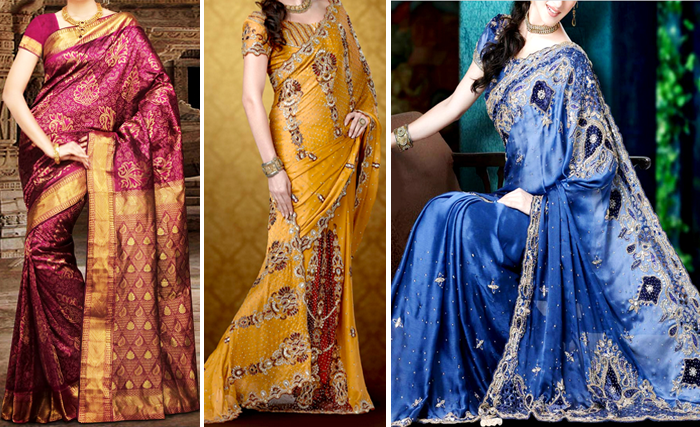Source:- Google.com.pk
A wedding sari is the traditional wedding dress of Indian women. The sari is traditionally red, with golden embroidery. Saint Thomas Christians from Kerala usually wear golden, white or cream saris with gold embroidery.
Red saris are the traditional garment choice for brides in Indian culture. Sari fabric is also traditionally silk. Over time, color options and fabric choices for Indian brides have expanded. Today fabrics like crêpe, Georgette, tissue and satin are used, and colors have been expanded to include gold, pink, orange, maroon, brown, and yellow as well.[1][citation needed] Indian brides in Western countries often wear the sari at the wedding ceremony and change into traditional Indian wear afterwards (lehenga, choli, etc.).
A saree or sari[22][23] is a female garment in the Indian subcontinent.[24] A sari is a strip of unstitched cloth, ranging from four to nine meters in length, that is draped over the body in various styles. There are various traditional styles of saree: Sambalpuri Saree from East, Kanchipuram from South, Paithani from West and Banarasi from North among others.[25] The most common style is for the sari to be wrapped around the waist, with one end then draped over the shoulder baring the midriff.[24] The sari is usually worn over a petticoat.[26] Blouse may be "backless" or of a halter neck style. These are usually more dressy with a lot of embellishments such as mirrors or embroidery and may be worn on special occasions. Women in the armed forces, when wearing a sari uniform, don a half-sleeve shirt tucked in at the waist. Teenage girls wear half-sarees, a three piece set consisting of a langa, a choli and a stole wrapped over it like a saree. Women usually wear full sarees.
Saris are usually known with different names in different places. In Kerala, white saris with golden border, are known as kavanis and are worn on special occasions. A simple white sari, worn as a daily wear, is called a mundu. Saris are called pudavai in Tamil Nadu. In Karnataka, saris are called Seere.[27]
lothing in India varies from region to region depending on the ethnicity, geography, climate and cultural traditions of the people of that region. Historically, men and women clothing has evolved from simple Langotas, and loincloths to cover the body to elaborate costumes not only used in daily wear but also on festive occasions as well as rituals and dance performances. In urban areas, western clothing is common and uniformly worn by people of all strata. India also has a great diversity in terms of weaves, fibers, colours and material of clothing. Colour codes are followed in clothing based on the religion and ritual concerned. For instance, Hindu ladies wear white clothes to indicate mourning, while Parsis and Christians wear white to weddings.
India's recorded history of clothing goes back to the 5th millennium BC in the Indus Valley civilization where cotton was spun, woven and dyed. Bone needles and wooden spindles have been unearthed in excavations at the site.[1] The cotton industry in ancient India was well developed, and several of the methods survive until today. Herodotus, an ancient Greek historian described Indian cotton as "a wool exceeding in beauty and goodness that of sheep".[2] Indian cotton clothing was well adapted to the dry, hot summers of the subcontinent. The grand epic Mahabharata, estimated to be written between 3000-4000 BC, has a mention of an uneding saree gifted to Draupadi to protect her dignity.[3] Most of the present knowledge of ancient Indian clothing comes from rock sculptures and paintings in cave monuments such as Ellora. These images show dancers and goddesses wearing what appears to be a dhoti wrap, a predecessor to the modern sari.The upper castes dressed themselves in fine muslin and wore gold ornaments[4] The Indus civilisation also knew the process of silk production. Recent analysis of Harappan silk fibres in beads have shown that silk was made by the process of reeling, a process known only to China until the early centuries AD.[5]
Indian Wedding Sarees lehnga design 2014 Latest for engagement images for kids for marriage for bride
Indian Wedding Sarees lehnga design 2014 Latest for engagement images for kids for marriage for bride
Indian Wedding Sarees lehnga design 2014 Latest for engagement images for kids for marriage for bride
Indian Wedding Sarees lehnga design 2014 Latest for engagement images for kids for marriage for bride
Indian Wedding Sarees lehnga design 2014 Latest for engagement images for kids for marriage for bride
Indian Wedding Sarees lehnga design 2014 Latest for engagement images for kids for marriage for bride
Indian Wedding Sarees lehnga design 2014 Latest for engagement images for kids for marriage for bride
Indian Wedding Sarees lehnga design 2014 Latest for engagement images for kids for marriage for bride
Indian Wedding Sarees lehnga design 2014 Latest for engagement images for kids for marriage for bride
Indian Wedding Sarees lehnga design 2014 Latest for engagement images for kids for marriage for bride
Indian Wedding Sarees lehnga design 2014 Latest for engagement images for kids for marriage for bride










Priyak Blog is the leading site for beauty and fashion tips and advice. Look your best with our beauty tips, makeup ideas, Shopping Guide, Clothing, how to use Best Beauty Products, home remedies soultions and more.
ReplyDeletehttp://priyakblog.com